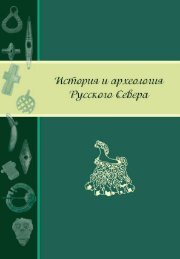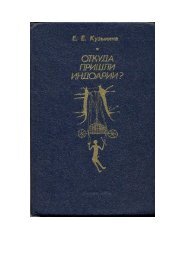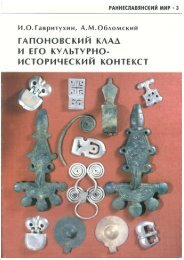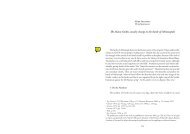The Archaeology of Celtic Art
The Archaeology of Celtic Art
The Archaeology of Celtic Art
- No tags were found...
You also want an ePaper? Increase the reach of your titles
YUMPU automatically turns print PDFs into web optimized ePapers that Google loves.
LATER BRONZE AGE AND HALLSTATT ORIGINSBody-armour too was developed with the new skill <strong>of</strong> sheet bronze-working fromthe Bronze D phase. Though the fragments from the wealthy tumulus burial fromČaka, Levice, in western Slovakia may at first sight seem almost risibly small to sustainthe full-scale reconstruction <strong>of</strong> the bronze corselet, later examples like that fromMarmesses in the Haute-Marne (Figure 2.6a) leave no doubt as to its identification andpurpose. Body armour, including greaves, was evidently being made from the earlyUrnfield period in sheet bronze, but there is every probability that such items weremade much earlier from perishable, organic materials. Helmets (Hencken, 1971) havea still wider distribution. In Northern Europe, beyond the Urnfield zone, hornedhelmets <strong>of</strong> the later Bronze Age are matched in miniature on small bronze figurines.Central European types include those with a simple knobbed apex and a more conicalform with lateral flanges and projecting studs, and have a significant distribution southas well as north <strong>of</strong> the Alps. That these helmets with appropriate lining could haveserved in battle need not be challenged by the probability that they also served asprestigious head-gear for ceremonial occasions. Some <strong>of</strong> their Iron Age counterpartswere probably too richly embellished to hazard in battle, raising the probability thathead-gear was as much an indication <strong>of</strong> status or <strong>of</strong>fice as a means <strong>of</strong> protection.Bronze shields (Sprockh<strong>of</strong>f, 1930; Coles, 1962) also were an innovation <strong>of</strong> the lateBronze Age, possibly from the Bronze D phase <strong>of</strong> the thirteenth century in CentralEurope, though wooden or leather prototypes may have preceded the metal versionsfrom an earlier date. Circular or sub-circular in shape and ranging in diameter from lessthan 40 centimetres to more than 70, one widespread form is distinguished by havinga V-shaped or U-shaped ‘notch’ in its concentric raised ribs. <strong>The</strong> U-notched variant isconcentrated particularly in Northern Europe and the Danish peninsula; the V-notchedform is represented on rock carving in south-western Spain and is found as far east inthe Mediterranean as Cyprus. <strong>The</strong> distributions are virtually exclusive; only in Irelanddo they coincide. Principal among Central European shields is the Nipperwiese type,named after a type-site in Pomerania. <strong>The</strong> distribution is fairly sparse, with someregional variations, including examples from Britain (Needham, 1979). Native Britishshields, like the Yetholm type and other regional variants, are represented in greaternumbers, frequently from wetland contexts that may suggest a ritual role in theirdeposition (Coles et al., 1999). Though there is evidence that some were damaged byblows from weapons, the bronze shields would hardly have afforded practical protectionwithout wooden or leather backing. <strong>The</strong> survival <strong>of</strong> leather and woodenexamples from Ireland, and the fact that Hispanic rock-carvings must be representations<strong>of</strong> an organic type that has not survived, confirm the probability that theserepresented the utilitarian norm, and that bronze shields were largely for ceremonialpurposes.Feasting and drinking<strong>The</strong> earliest beaten bronze vessels associated with ceremonial and perhaps ritual feastingand drinking occur in the Bronze D phase <strong>of</strong> the thirteenth century bc in CentralEurope. By Hallstatt A1 in the twelfth century a typical set <strong>of</strong> vessels associated withfestive or ritual drinking was buried in the chieftain’s grave at Hart-an-der-Alz inBavaria. Apart from weaponry and some personal ornaments, the grave contained abeaten bronze bucket, and as accessories a handled sieve or straining cup and a handled30
















